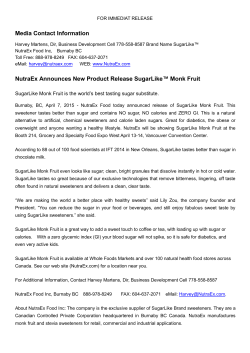
Breeding an Industrial Quality Pepper in INIA
Breeding an Industrial Quality Pepper in INIA-Chile: Progress and Advanced Lines Alan Pinto1,2, Ricardo Pertuzé3, Mabel Muñoz1, Gabriel Saavedra1, Francisco Álvarez1, María -Teresa Pino1*. 1Instituto de Investigaciones Agropecuarias (INIA), La Platina, Santiago Chile CP: 8831314, 2 Undergraduate-student Agronomy Universidad de Chile, 3 Universidad de Chile – Facultad de Agronomía. *Corresponding author: mtpino@inia.cl E-mail: adprichards@yahoo.com INTRODUCTION In the last years, demand for peppers and Capsicum-based products has increased significantly around the world, including canned, frozen, dried, paste, juice and colour extract for processing industry. This higher demand is explained in parts because of enhanced functional properties and health benefits. The objective of this investigation was to obtain advanced lines focused on the requirements of the industry. Materials and Method The Chilean Agricultural Research Institute (INIA) started in 2007 a Capsicum annuum L. breeding program in traits of industrial interest for fruit pepper quality such as colour, pericarp thickness, fruit dry matter, fruit sugar content, shape, size and high beta-carotenes content. Two years bulk crossing were done in order to increase the genetic variability, by crossing 22 landraces and varieties differing in colour, shape and Phytophthora capsici response. After bulk crossing, five sub-populations were selected, grouped and independently cultivated for further selection and self-pollination; Red bell blocky 4-lobed fruits (L1889), Red long blocky fruits (L1890), Yellow bell blocky 4-lobed fruits (L1891), Red bell blocky 4-lobed fruits (L1892) and Red long blocky fruits (L1893). After six years of recurrent selection of these sub-populations, we initiated the selection of advanced lines based on the industrial fruit quality traits (colour, pericarp thickness (>6mm), fruit dry matter (>10%), sugar content (>8°Brix), shape and size), fruit number/plant, fruit weight and yield/plant. During the last season and among 1,710 selected segregating lines, 65 advanced lines (under self-pollination) meet the industrial quality traits. Figure 3. Dendrogram in 65 advanced lines (Ward method and squared euclidean distance, Statgraphics Centurion XVI program. Copyright 2013 StatPoint Technologies). Two large groups were formed: Group I clustering the majority of advanced lines belong to sub-population L1892 (Red bell blocky 4-lobed fruits) and fruits with higher dry matter (%) and higher sugar content (°Brix). Group II clustering advanced lines belong to sub-populations L1889 and L1892 both Red bell blocky 4-lobed fruits, and L1891 (Yellow bell blocky 4-lobed fruits), this group include fruits with higher fruit fresh weight. Table 1. Centroids in Cluster Analysis. Cluster Colour 1 (blue) 2 (red) 1.28 1.00 Shape Pericarp Thickness Sugar Content Weight Dry Matter 3.83 1.66 5.54 5.30 a 269.59 154.39 b d Figure 1. INIA breeding program for Industrial Pepper 4.91 6.11 7.40 11.38 c e Figure 4. Descriptive Statistic Analysis: Phenotypic evaluations in five subpopulations: Yield (a), Pericarp Thickness (b), Sugar Content (c), Fruit Fresh Weight (d) and Fruit Dry Matter (e). RESULTS Figure 5. Advanced lines in the field under Self-pollination cages. Figure 6. Advanced line - fruit according to industrial characteristics. The best advanced lines were L1892-41-04 with pericarp thickness (6,3mm), fruit dry matter (13,6%), sugar content (≥7.5°Brix) and fruit fresh-weight (233g) and Line L189218-18 with pericarp thickness (6,4 mm), fruit dry matter (12,4%), sugar content (≥8.1°Brix) and fruit fresh-weight (151g). Figure 2. Principal component analysis (PCA) for 65 advanced lines of Capsicum annum of fruit industrial traits. PCA showed that 55.22% of total variance was explained with component 1 and component 2 (eigenvalue method, Statgraphics Centurion XVI. Copyright 2013 StatPoint Technologies). The over all analysis show that more stable characters were: pericarp thickness and sugar content with 16.9% and 30% of coeficient variation respectively. So, variation coefficient and genetic variation are narrowing, so the material to have is also more stable. Acknowledgements, this research was carried out with financial support from INNOVA-CORFO (09PMG-7244)
© Copyright 2025















